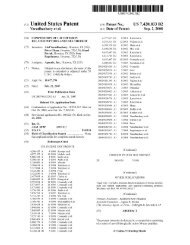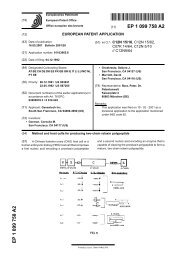EP 1 211 261 A2
EP 1 211 261 A2
EP 1 211 261 A2
Create successful ePaper yourself
Turn your PDF publications into a flip-book with our unique Google optimized e-Paper software.
<strong>EP</strong> 1 <strong>211</strong> <strong>261</strong> <strong>A2</strong>5101520253035for slightly higher values (approximately 5 mmHg) during the HBOL period for systolic, diastolic and mean arterialpressure. Commensurate with the increase in blood pressure was an increase in total peripheral resistance, generallywithin the first 4 hours. Cardiac index declined during the HBOL period (~ 0.5 l/min/M 2 ). Pulse was about 5-10 beatslower during the HBOL than the ATX period. These findings have been observed in the HBOL studies and have beenof little clinical concern.[0289] Pulmonary function tests were unremarkable except for a 14% increase above baseline in diffusion capacityafter the ATX and HBOL infusions. Subjects were able to achieve similar exercise capacity during HBOL and ATXperiods. Arterial blood gas measurements during peak exercise (anaerobic threshold) were similar in both periods, butarterial pO 2 tended to be higher during the HBOL period. Plasma lactic acid levels were lower during the HBOL thanATX period. Resting metabolic art measurements indicated that oxygen consumption, carbon dioxide production andmetabolic energy expenditure were greater during the HBOL than ATX period. The comparison as mentioned aboveis roughly one gram of HBOL to 3 grams of ATX. The diffusion capacity coupled with the observations about VO 2 andVCO 2 indicate that more oxygen is being delivered to the tissue level per gram of HBOL than ATX. It is commonly heldthat the diffusion capacity varies directly with the hemoglobin level, however, there is a suggestion that 1 gram ofplasma hemoglobin may increase diffusion capacity as much as 3 gms of RBC hemoglobin.[0290] Laboratory studies were notable for small, but transient increases in ALT, AST, 5'-nucleotidase, lipase andcreatine kinase during the HBOL period. There were no abnormal urinary finding.[0291] Hematological studies were consistent with those in Example 7.[0292] The observed medical events were consistent with expected findings related to the phlebotomy (e.g., vasovagalepisode), multiple pulmonary function tests (eructation or abdominal "gas"), arterial line insertion (e.g., pain ortingling over the insertion site) or numerous everyday complaints that one might observe in normal subjects over thecourse of a month (e.g., headache, upper respiratory tract infection or cold). The one subject (Subject #105) that hadabdominal "gas" and pressure in the mid-epigastrium, but without dysphagia is suggestive of other gastrointestinalcomplaints that have been observed in previous HBOL studies. L-arginine was used as a therapeutic measure basedon the concept that hemoglobin can interfere with endogenous nitric oxide function (nitric oxide is integral in the relaxationof gastrointestinal smooth muscle, especially in the esophagus and intestines). L-arginine is the substrate uponwhich nitric oxide synthase produces nitric oxide. Theoretically, if one has a reduction in nitric oxide from the hemoglobin(perhaps binding of heme to nitric oxide), then administration of L-arginine might be of benefit. Apparently the subjectdid get marked by transient relief from his symptoms with the L-arginine for about two hours. This is not an unexpectedfinding because the plasma half-life of L-arginine is about an hour. Unfortunately, some of the side effects (nausea andvomiting) occurred and the infusion was stopped. We elected to give him a two doses of an anticholinergic, antispasmodicdrug, hyoscyamine. This apparently continued to reduce the symptoms of abdominal "gas" and pressure. Thesubject had no further complaints or sequelae.[0293] In summary, HBOL was associated with improved oxygen delivery and utilization during exercise and at rest.HBOL produced a similar spectrum of hemodynamic, safety laboratory results, pharmacokinetics and medical eventsto what has previously been observed. Intervention with L-arginine may produce a reversal of gastrointestinal symptoms,but its use was limited by nausea and vomiting. However, the use of anticholinergic therapy might be of valuein the treatment for the gastrointestinal symptoms that are encountered.40Example 9Study of Tissue Oxygenation from Infusing Polymerized Hemoglobin Solution after Hemodilution455055[0294] In this study, regional tissue oxygenation levels were measured in the left hind limb muscle (m. gastrocnemius),within an 8-dog experimental group, to determine the effects of infusion of polymerized hemoglobin solution uponanimals made anemic by isovolemic hemodilution with a non-oxygen bearing solution.[0295] Regional tissue oxygen partial tensions were determined, using a Sigma-pO 2 -Histograph (Model No. KIMOC6650, Eppendorf-Netherler-Hinz GmbH, Hamburg, Germany), to measure at least 200 local pO 2 values in the skeletalmusculature distal to the exposed femoral artery, and then display the pO 2 values in a histogram for each measurementpoint.[0296] At each measurement point, the Eppendorf pO 2 -Histograph measured oxygen partial pressure polarographicallywith an oxygen needle probe having a spring steel casing containing a glass-insulated, teflon-coated gold microcathode.The oxygen needle probe was polarized with -700 mV towards an Ag/AgCl anode, which was attached tothe skin near the site of the oxygen needle probe insertion. The resulting current was proportional to the oxygen partialpressure at the electrode tip, thus giving a measurement of local tissue oxygenation.[0297] Regional oxygenation measurements were obtained automatically with the aid of a microprocessor-controlledmanipulator, which moved the oxygen needle probe through the tissue in a series of "pilgrim steps", each typicallyconsisting of a forward motion of 1 mm followed by a backward motion of 0.3 mm, to relieve compression of the tissue32




